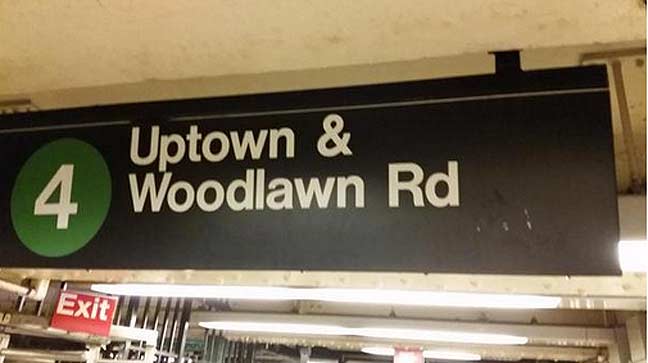One of the more curious aspects of the Metropolitan Transit Authority is that it will preserve archaic street names for no apparent reason. There was a rationale for preserving older Queens street names, as the Astoria line, the Liberty Avenue line, the Flushing Line and the Rockaway line do, because when these els were built, the old names were still fresh in the minds of oldtimers; Queens streets were renumbered beginning in 1915, a process that took about 15 years to finish.
But the persistence of the Woodlawn Road signs on the Jerome Avenue line, or the #4 train, is something of a headscratcher. Woodlawn Road is simply the old name of Bainbridge Avenue between East 205th and Jerome Avenue at the Woodlawn Cemetery entrance. The name was changed decades ago to a northern extension of Bainbridge (creating a very odd intersection, but I’ll get to that on a future page). But I’ve seen station and roll signs (in the old cars) saying “Woodlawn Road” as long as I’ve been riding the trains.
Well, as in Queens, the MTA has always done it this way. Why stop now?
Photo: Tim R.
9/3/14


7 comments
Up until the 2000’s the F Train stop was 22nd Ave Bay Parkway. The name has been Bay Parkway since the 1930’s.
thanks for thearticle about the harlem division stations. Melrose,morrisania,east 183rd street,botanical garden and woodlawn were all wooden stations built on a foundation of steel girders crossing over the right of way. the interiors were oak strips on the walls and the outside was covered with some sort of metal siding to mimic wood panels which required periodic painting. I grew up on east 162nd street and we always used “The Central”. I remember when there was a ticket agent. The furnace was on the platform under the stairway which led up to the street
most of the New York Central’s Harlem Division stations were actually wood inside and out. the interiors were oak. the exteriors were wood covered with some sort of metal which was supposed to appear to be wood panels. it required painting but I suppose it was intended to give a more unique look to the building. I lived up the street on east 162 between park and morris avenues. you could always tell train time by the people heading down street in the am and back up in the pm. We always rode “The Central” to Manhattan. I was disappointed that the ride was so fast
I always thought that the TA called it Road instead of Cemetery. Would you get on a train going to “Woodlawn Cemetery?” Willoughby, next stop Willoughby…
My Grandfather always told me when going from S.I. to Yankee Stadium “Take the Woodlawn-Jerome line.” When we would go to Brooklyn from Whitehall St. He would tell me to take the train with 2 green lights. A real old timer.
Not related but of interest. Rumblings about what to do with the old Sanitation horse barn on S.I.:
http://www.silive.com/northshore/index.ssf/2014/09/city_sanitation_department_sit.html
Actually, the first mention of Woodlawn Road appeared on the subway roll signs for cars purchased in 1939. The LoVs which operated on the #4 until 1964 (although the train beared no number designation) said “Woodlawn -Jerome”, as did all station signage. When the Worlds Fair opened in April, 1964, the trains purchased for the first Worlds Fair were shifted to the number 4 and the Woodlawn Road designation began appearing on the subway cars. the Flushing line received new cars. I am not even sure if the name existed even in 1964 because I never could find it on any map.
As far as I can remember the station was simply called “Woodlawn” on the maps and on the platform signs. The IRT postwar equipment, R17 through R33 that operated on the #4, did use the term “Woodlawn Road” on the cars’ roll signs, though that was never the official name of the last stop.
The only place I can ever saw an actual “Woodlawn Road” was in Bermuda, on the way to Somerset at its far west end. Did not see the #4 train nearby!